Bulletin – December 2010 China's Steel Industry
Abstract
China's steel industry has grown rapidly in recent decades, with China now the world's largest producer and consumer of steel. This has resulted in a sharp increase in demand for iron ore and coal, Australia's two largest exports, which are key inputs for the steelmaking process. This article discusses the growth of the Chinese steel industry over the past couple of decades.
Introduction
Over the past 30 years, China's steel production has increased at a rapid pace as the economy has industrialised and urbanised. The expansion of steel production, particularly over the past decade, has been a significant driver of China's demand for raw materials, especially iron ore and coking coal. This has resulted in a considerable increase in China's imports of these commodities. This article discusses the Chinese steel industry, focusing on its structure, the geographical distribution of its steel production and recent developments.
Growth of the Chinese Steel Industry
Since the introduction of market-based economic reforms in 1978, the Chinese economy has grown strongly, recording an average annual growth rate of around 10 per cent. Over this period, Chinese steel production has also expanded rapidly, growing at an average annual rate of 7 per cent during the 1980s, 10 per cent during the 1990s and close to 20 per cent in the 2000s (Graph 1).
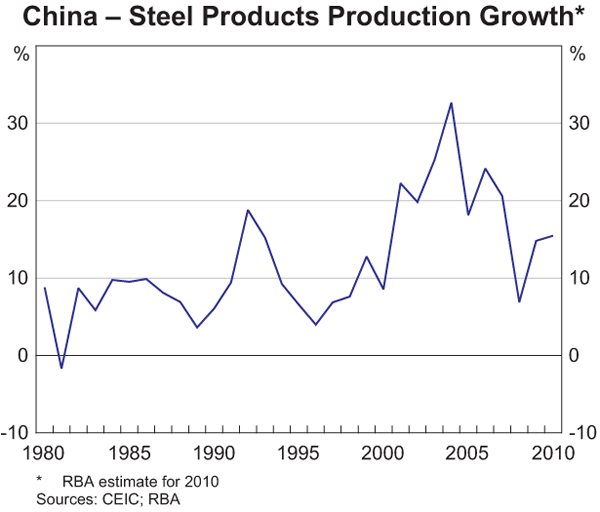
This expansion reflects the large-scale industrialisation and urbanisation of the Chinese economy over this period, developments which have driven much of the growth of investment in infrastructure, buildings and machinery. The process of industrialisation has also been accompanied, to some extent, by market liberalisation in the steel sector. This includes efforts to increase the autonomy of state-owned enterprises in the early 1980s that gave steel companies some independence from the government, and allowed them to invest surplus funds to improve their facilities and expand their productive capacity. Through the 1980s and 1990s, the productivity of the sector was enhanced by the opening up of China to foreign trade and investment, which gave Chinese steel producers increased access to advanced technologies.
The sustained growth in steel production has seen a pronounced rise in the ‘steel intensity’ of the Chinese economy (measured as steel output per unit of GDP), which is broadly similar to increases that have occurred in other countries that have industrialised and urbanised (Graph 2). If China is to follow the same general pattern, a decline in steel intensity would be expected over time as the service sector expands, although steel intensity could stay high for another decade or so.
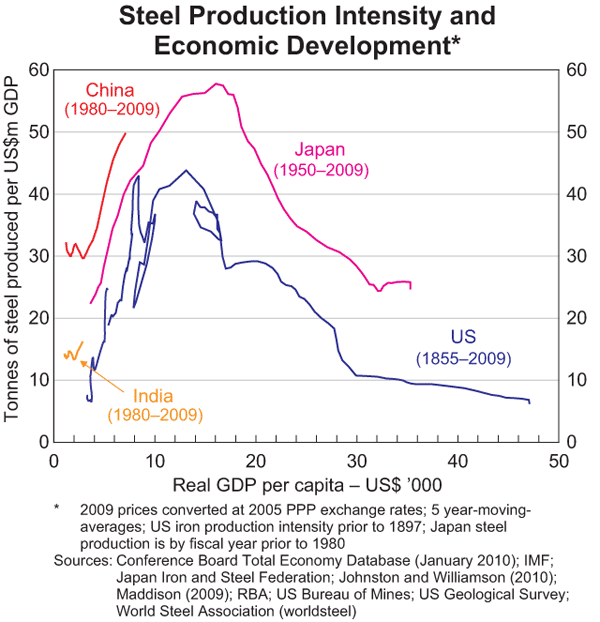
The combination of strong economic growth and rising steel intensity has resulted in a steady rise in China's share of global steel production over the past 10 years. China now accounts for around 45 per cent of global steel production, which is significantly higher than its share of 15 per cent at the start of the decade (Graph 3).
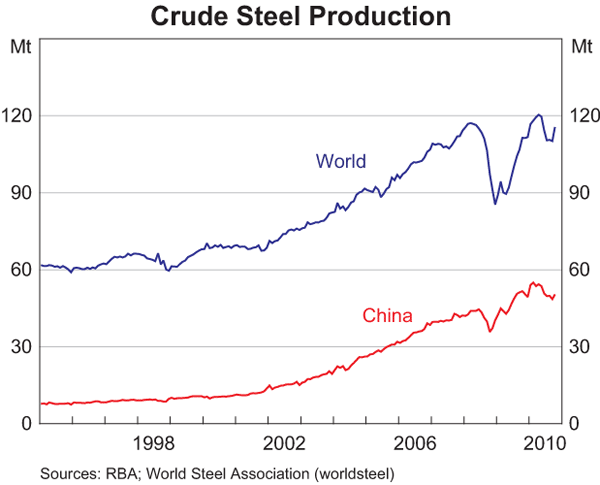
Structure of the Chinese Steel Industry
The Chinese steel industry is highly decentralised, consisting of a relatively small number of large, advanced steelmakers and a large number of small- and medium-sized firms that produce lower-value steel products. In 2008, there were more than 660 companies producing crude steel, with thousands of other firms producing finished steel and steel-related products. The top 10 producers accounted for less than 50 per cent of crude steel output, with the next 75 companies accounting for an additional 30 per cent (State Council 2009, CISA 2009). Most of the larger Chinese steel producers are state-owned, while a significant proportion of the smaller producers are private companies.
Geographically, the industry is widely dispersed. The coastal provinces account for around 65 per cent of crude steel production, with the concentration of steel production in the north-east of the country partly reflecting proximity to major iron ore mines, particularly in Hebei and Inner Mongolia (Figure 1). The north-eastern ports of Qingdao (Shandong province), Shijiazhuang (Hebei province) and Tianjin received more than half of China's iron ore imports in 2009, consistent with their proximity to major steel-producing centres (The TEX Report 2010).
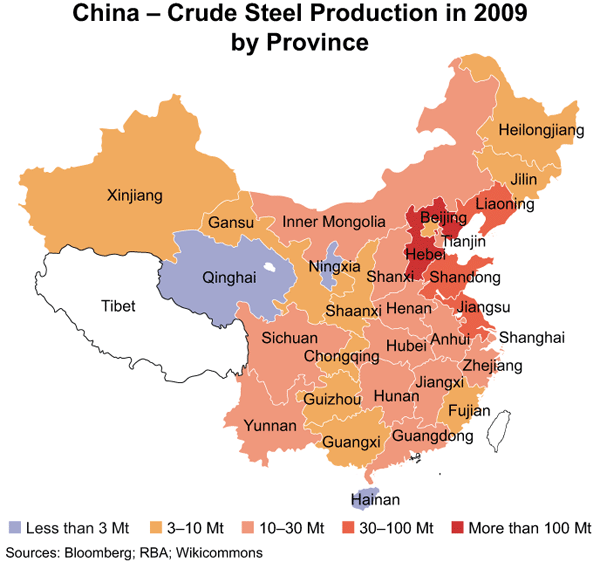
The decentralised structure of the industry and the physical dispersion of steel production have raised concerns among Chinese policy-makers that the industry's lack of consolidation may be hampering its ability to exploit economies of scale. Concerns about consolidation have sometimes also been linked to perceptions of overcapacity in some parts of the industry, especially the presence of a large number of small, relatively inefficient producers. The continued use of outdated, high-polluting facilities by some smaller producers has also prompted concerns about the impact on the environment.
In July 2005, the National Development and Reform Commission issued a formal policy on steel that sought to spur consolidation by increasing the concentration of steel production among large producers, and to protect the environment by reducing energy consumption and eliminating obsolete production capacity. Targets for industry consolidation through mergers and acquisitions or closures of small- to medium-sized firms were outlined. In June 2010, the State Council updated these targets, announcing that the production share of the 10 largest steelmakers was to rise from 44 per cent in 2009 to 60 per cent by 2015, with a goal of cultivating three to five very large, internationally competitive iron and steel conglomerates (State Council 2010).
Steelmaking in China
Crude (or unprocessed) steel can be produced either directly from iron ore and coking coal using the blast furnace/basic oxygen converter method, or from scrap steel (and other inputs) using the electric arc furnace method. In the United States and Europe, where the electric arc furnace technology is commonly used, between one-half and two-thirds of steel is produced using scrap. In contrast, in China more than 90 per cent of crude steel is produced by steelworks using blast furnaces and basic oxygen converters (World Steel Association 2010). This reflects difficulties with the supply of electricity in some parts of China and low domestic availability of ferrous scrap, due to relatively low household consumption of steel-intensive manufactures and limited scrap collection and processing systems. The prevalence of the converter method has important implications for resource demand: on average, each tonne of Chinese steel requires around 1.7 tonnes of iron ore and more than half a tonne of coking coal as inputs. This helps explain the significant increase in China's demand for these resources over the past decade.
The demand for raw materials is met from both domestic and foreign sources, but the majority of iron ore is sourced from abroad. China is itself a major producer of iron ore and possesses extensive reserves. However, these reserves have relatively low average iron content at around 33 per cent, compared with 62 per cent in Australia and around 65 per cent in Brazil and India (Jorgenson 2010). This lower iron content makes it more expensive to process. Moreover, the bulk of iron ore reserves are located inland in the north and west of China. While steel mills in the north-east are close to major iron ore mining precincts, it is costly to transport ore to steel mills located elsewhere in the country.
Strong demand for steel has seen the imported share of iron ore supply increase from around 10 per cent in the late 1980s to more than 50 per cent currently (Graph 4), although over the past five years China's iron ore output has generally kept pace with growth in steel production. This reflects a number of factors, including the high price of imported iron ore and the temporary downturn in steel demand associated with the global financial crisis. More recently, iron ore imports have remained at a high level, having picked up sharply as the Chinese economy recovered from the downturn in late 2008 and early 2009 aided by the substantial fiscal stimulus, although domestic production has also been strong.
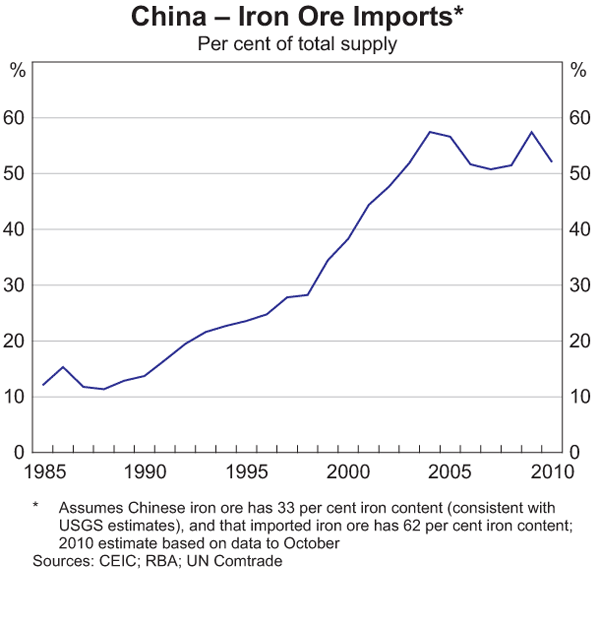
In recent years, more than 80 per cent of China's iron ore imports have come from Australia, Brazil and India. In an effort to diversify supply, Chinese policymakers have encouraged direct investment by Chinese companies in iron ore exploration and iron ore mines abroad. To date, numerous investments have been made in West Africa, South America, Central Asia, Russia, Australia and Canada, many of which are large in scale. While efforts to diversify supply may have implications for the Chinese steel industry's sourcing of raw materials in the future, the likelihood of continued high rates of economic growth suggests that China's imports of raw materials will remain high.
Until very recently, China was largely self-sufficient in coking coal, with domestic production supplying the bulk of the steel industry's needs. However, in the first half of 2009, coking coal imports surged, with a pronounced effect on Australian coking coal exports to China. This surge reflected a combination of factors, including a strong rise in steel production, a significant decline in international freight rates, and lower Chinese production of coal owing to efforts to consolidate the coal sector and mine closures or renovations for safety reasons. While China has extensive reserves of coking coal, many of its existing deposits are relatively inaccessible and therefore costly to mine. Many of these deposits are also far from major steel-producing areas (ABARE 2009, 2010).
Supply and Demand
On the supply side, China's steel industry has traditionally focused on the production of ‘long’ products, which are widely used in residential and non-residential construction (such as bars, wires, tubes and sections). However, in recent years, higher value ‘flat’ products, which are used extensively in manufacturing (such as steel strips and sheets), have accounted for a rising share of production (Graph 5). Although China can satisfy most of its own steel requirements, the composition of its production has meant that over recent years around 2½ per cent of steel has been imported, especially some higher quality, technology-intensive flat products.

The main source of steel demand is investment in buildings, structures and machinery. Over the past three decades, gross fixed capital formation has risen from around 30 per cent of GDP to around 45 per cent, partly driven by reforms opening up China's internal and external markets, and a large-scale process of rural-urban migration. The construction industry is the largest direct consumer of Chinese steel products, accounting for more than one-half of steel consumption (Table 1), consistent with a product mix emphasising long products. However, at least a quarter of steel consumption can be considered broadly as ‘manufacturing’, including the machinery, automobile and home appliance industries.[1]
| Industry | Share of total steel consumption |
|---|---|
| Construction | 54 |
| Machinery | 18 |
| Automobile | 6 |
| Home appliance | 2 |
| Rail, shipping and fuel(a) | 5 |
| Other | 15 |
|
(a) ‘Rail, shipping and fuel’ is defined as the sum of the ‘container’, ‘railway’, ‘shipbuilding’ and ‘petroleum’ categories Source: Wu (2009) |
|
Since 2006, China has been a net exporter of steel products (Graph 6). The early 2000s saw a large increase in steelmaking capacity, partly reflecting an increase in the number of small- and medium-sized firms; this growth in capacity translated into higher production, some of which flowed onto the international market. Since China's accession to the World Trade Organization in 2001, the volume of steel exports has increased noticeably; however, steel exports have not recorded sustained growth, and over the past few years have been declining as a share of total domestic production. At times when steel production has risen faster than domestic demand for steel, such as during the 2008 slowdown, China's steel exports have surged, only to decline again when domestic demand for steel has recovered, as was the case during 2009.
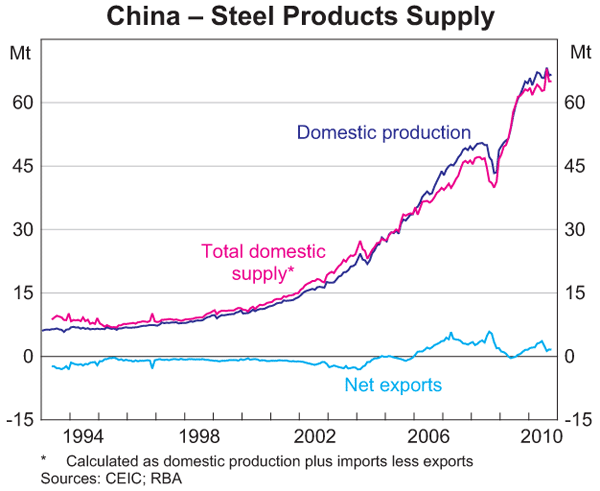
Recent Developments
Having grown very rapidly since the start of the decade, steel output slowed sharply in 2008 as growth in the Chinese economy eased in line with the global downturn. In late 2008 the government announced a large-scale fiscal stimulus package focused on public infrastructure and housing construction, which boosted GDP growth substantially in 2009 and generated significant demand for steel. Although growth in fixed asset investment has eased over the past year, it remains high, particularly in the manufacturing and real estate sectors, and growth in automobile production has been robust. While these indicators suggest that final demand for steel has remained solid, in 2010 to date there has been little growth in the production of finished steel products, and crude steel production has moderated (Graph 7).
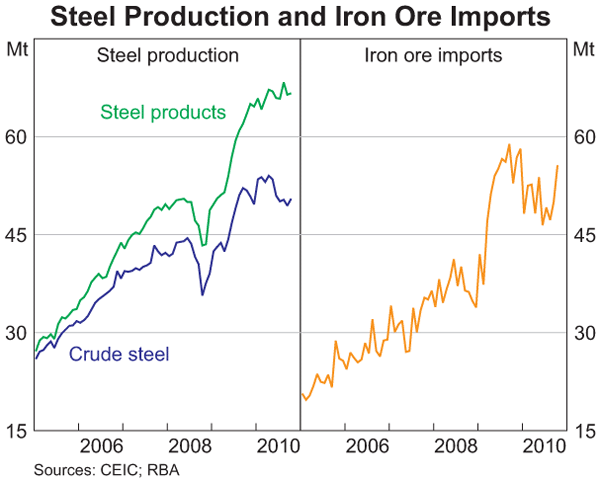
This recent slowing in steel production reflects a combination of factors, including policy measures introduced by the central government in April 2010 aimed at cooling the property market, and the scrapping of export rebates for 48 steel products in July. In addition, selected steel mills received notices in September to reduce steel production by the end of 2010 in an effort to meet national five-year energy intensity targets, which form part of the government's environmental objectives. Despite the relatively subdued production of steel, China's demand for resources has been strong and this is reflected in higher prices for iron ore and coking coal, which have contributed significantly to Australia's high terms of trade (Graph 8). As the Chinese economy develops and the urbanisation process continues over the next decade or so, the production and consumption of steel are likely to rise further, underpinning strong demand for both iron ore and coking coal.
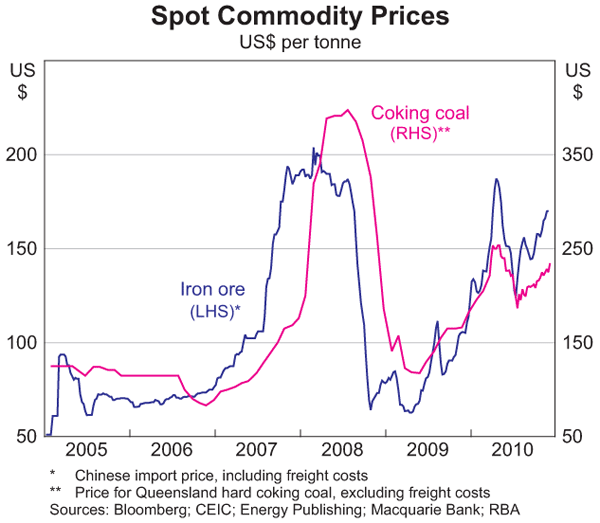
References
ABARE (Australian Bureau of Agricultural and Resource Economics) (2009), Australian Commodities, 16(4), December, pp 670–677.
ABARE (2010), Australian Commodities, 17(1), March, pp 168–179.
CISA (China Iron & Steel Association) (2009),
![]() 2009 (China Iron and Steel Statistics 2009), China Iron & Steel
Association Information and Statistics Department, Beijing.
2009 (China Iron and Steel Statistics 2009), China Iron & Steel
Association Information and Statistics Department, Beijing.
Johnston L and SH Williamson (2010), ‘What Was the U.S. GDP Then?’, MeasuringWorth.
Available at: <http://measuringworth.com/usgdp/>.
Jorgenson JD (2010), ‘Iron Ore’, U.S. Geological Survey Minerals Yearbook:
Volume I. – Metals and Minerals – 2008, U.S. Geological Survey,
Washington DC, pp 39.1–39.21.
Available at: <http://minerals.usgs.gov/minerals/pubs/commodity/iron_ore/myb1-2008-feore.pdf>.
Maddison A (2009), ‘Statistics on World Population, GDP and Per Capita GDP,
1-2008 AD’.
Available at <http://www.ggdc.net/Maddison/Historical_Statistics/horizontal-file_02-2010.xls>.
Roberts I and A Rush (2010), ‘Sources of Chinese Demand for Resource Commodities’, RBA Research Discussion Paper No 2010–08.
State Council (General Office of the State Council of the People's Republic of
China) (2009),
![]() (Iron and Steel Industry Restructuring
and Revitalisation Plan), 20 March.
(Iron and Steel Industry Restructuring
and Revitalisation Plan), 20 March.
Available at: <http://www.gov.cn/zwgk/2009-03/20/content_1264318.htm>.
State Council (2010), ![]()
(Several Observations on Boosting Energy Conservation and Emissions Reductions and
Accelerating Restructuring of the Iron and Steel Industry), Document No 34
(2010), 17 June.
Available at: <http://www.gov.cn/zwgk/2010-06/17/content_1629386.htm>.
The TEX Report (2010), ‘China's 2009 Iron Ore Imports by Discharge Port’,
3 February.
Available at: <http://www.texreport.co.jp/xenglish/eng-genryou/201002/201002031046Wed-2.html>.
World Steel Association (2010), Steel Statistical Yearbook 2010, World Steel Association, Brussels, pp 29–33. Available at: <http://www.worldsteel.org/pictures/publicationfiles/SSY 2010.pdf>.
Wu J (2009), ‘The Recent Developments of the Steel Industry in China’, Document No DSTI/SU/SC(2009)15, presented to the OECD Steel Committee Meeting, Paris, 8–9 June.